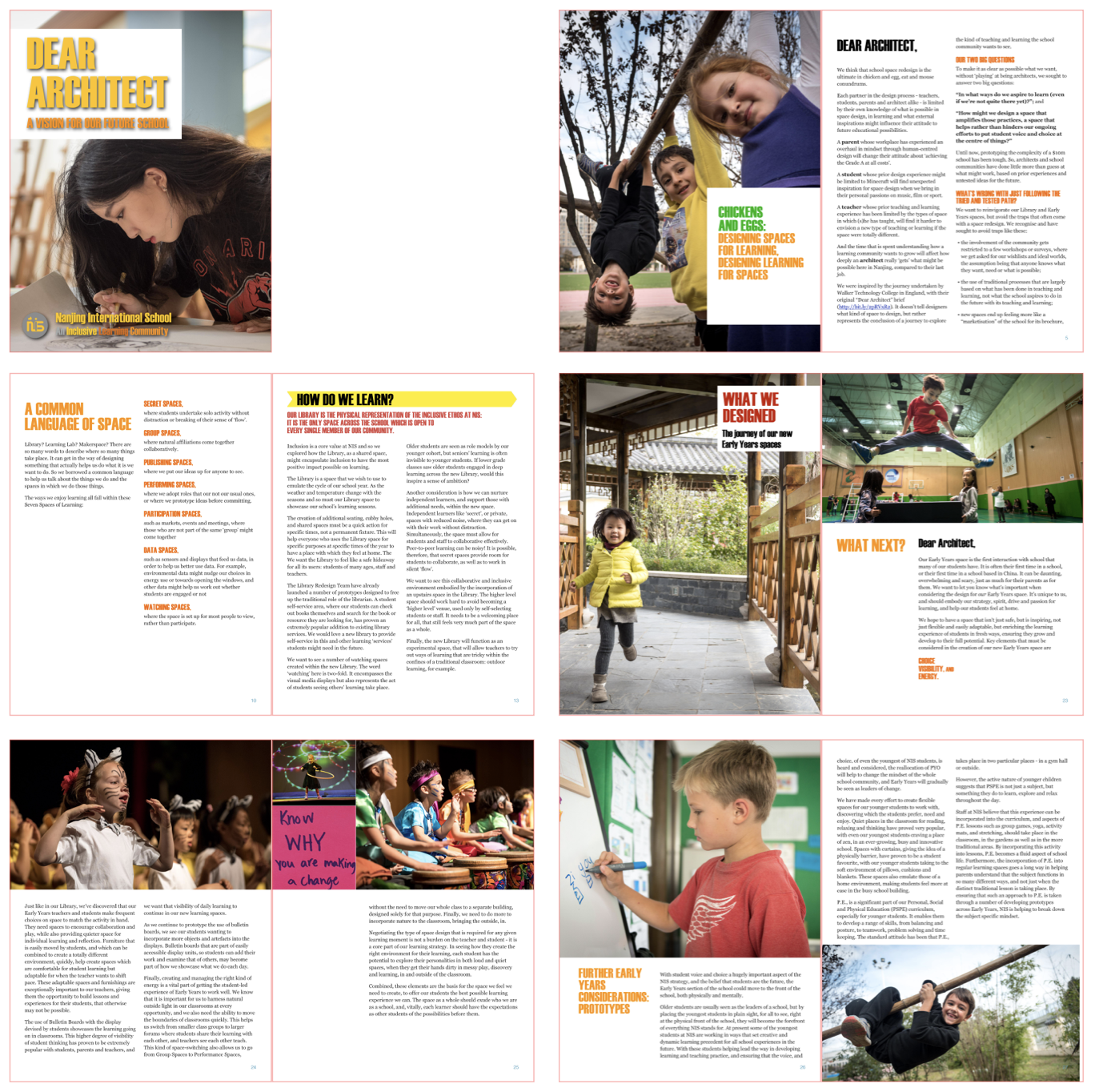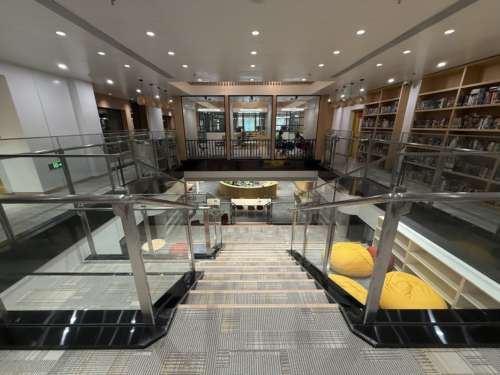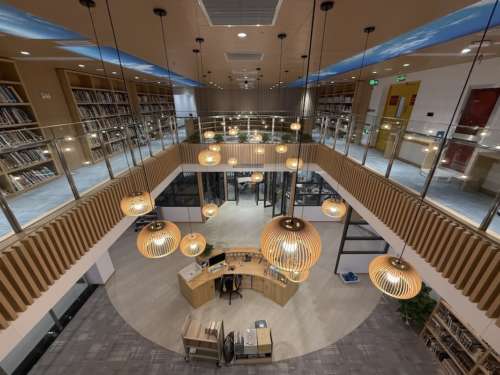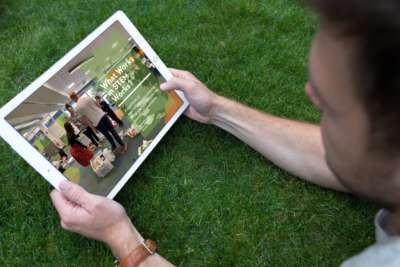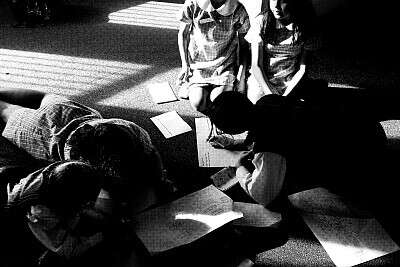The HUB at Nanjing International School
Nanjing International School, China
Challenges
The single-storey library occupied a large volume, meaning it felt echoey, impersonal, unwelcoming, despite the best efforts of library staff. Students and faculty desired a richer choice of cosy and inviting spaces, which could extend the possibilities of their learning beyond a traditional classroom.
Objective
Rethink the use of a large single-storey space so that the existing library is repurposed into a space that more students can use, and which provides richer opportunities for students to learn in different ways.
Approach
To reinvigorate the library, we reinvigorated perceptions of what libraries are for, and how people use them. We involved staff, faculty and students in provocation workshops where we shared ideas from many perspectives that challenged the usual ways these spaces might be used. We drew on retail, office and school spaces, and community library projects from Oslo to Los Angeles.
We wanted to create an environment that enticed students in, where they felt at home with the choice of which space to use. We also learned that students need to build up a skillset to use their voice effectively, to make stronger choices about which space suits the task at hand and then use it to its best.
The results from our early experiments highlighted a need for three new types of spaces, which didn’t feature in the school at the time. We drew on our ‘Seven Spaces of Learning’ framework, narrowing down the priorities to:
Secret spaces, or ‘caves’; here students can find quieter spots to develop their focus.
Group spaces, or watering holes and campfires, where students can collaborate without fear of interrupting others; and
Presentation spaces, or ‘holodecks’, where students can get plenty of practice and opportunity to share their ideas with smaller groups than the school’s traditional classrooms or theatres might provide.
Faculty and library staff then tested out their hypothesis over three months of experiments in their classrooms and the library: self checkout was introduced; curation ideas were trialled to show students the breadth of the offering; curtains divided the space effectively into quieter, more cozy zones; a weekend opening for families showed what a library feels like when hundreds are using it at once.
Their findings gave us strong support for designing a space that allows for a maximum number of students to use the space at any one time, rather than a transactional traditional ‘library’ space where students go for one purpose - to find a book - and leave as efficiently as possible.
Solutions Implemented
Our partners at EIW Architects picked up the baton to respond to the needs of the students, teachers, and leadership team. They regenerated a single-volume space into a three-level environment.
Watch the case study video
Play VideoStudent choice is the paramount principle behind the design of 30+ different types of learning space. Each caters for different tasks, group sizes and resource accessibility. The HUB also reinforces the school’s continued strong brand identity as part of the exciting developments in Nanjing.
The HUB represents the third space designed through the collaborative NoTosh process. EIW created a simple, coherent design language so that the whole campus reflects that ‘uniquely Nanjing’ context.
For example, EIW articulated:
· the connection to nature,
· the access to daylight,
· the curves that welcome and spark conversation and,
· the cultural context through screening to define space and echoes of the Nanjing wall
While the space is designed as a learning HUB for students primarily, it attracts staff and parents for other activities. Large-scale whole-faculty activities take place with a productive buzz, while during the day small niches cater to incidental meetings, and large-scale learning areas set groups up for being receptive to focused presentations and debates.
The HUB is designed to feel welcoming and comfortable for students, above all. It celebrates the best of student agency and self-direction, promoting opportunities for children to seek and discover a space that works for what they want to achieve.
Laurie McLellan, Director
“There were never barriers when sharing ideas with our architects and NoTosh…there was a profound convergence of belief in allowing dreams to become a reality."

Key outcomes:
1. Multifunctional spaces, thoughtfully located. Although the new space across its three floors can accommodate hundreds of students or adult learners on professional learning days, the sound level of 100+ people learning in a purposeful activity is a relatively quiet productive buzz thanks to the division of the space across three floors, and the use of a stairway and softer materials to mitigate noise.
2. Decluttering and deprioritising less-used books to higher shelves will remain a constant priority, but even with a full collection there is still room on the shelves for more, freeing up space for students to remain in the space in comfort.
3. Autonomy in the way students choose spaces is part of the school's overall strategic priority of putting student voice and choice at the centre of everything they do. The collections desk is set at three levels to enable self-checkout and check-in of books by students themselves.
4. Visibility between learning spaces is high, allowing students to see how other students learn when they need to.
5. Pathways in the space are designed to take students to spaces they might not have considered for a particular task, meaning they get into the habit of choosing the best space for the job, rather than setting into a learning space rut.
The HUB is just that: a hub for creativity and curation across the whole school.
Push boundaries before you draw them
The "Dear Architect" document provides the design principles for spaces that extend people beyond the practices of today
